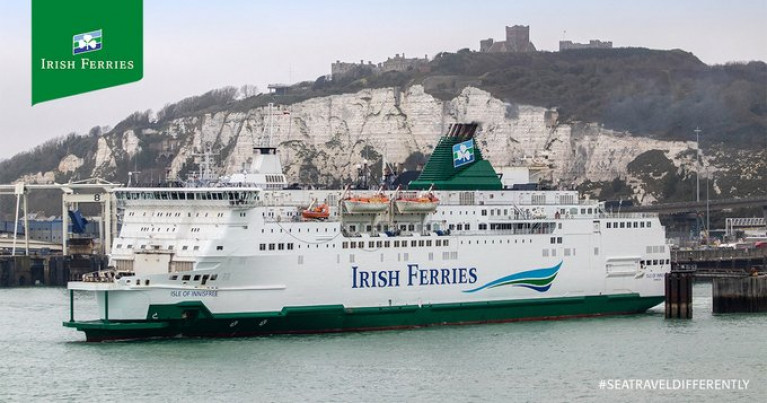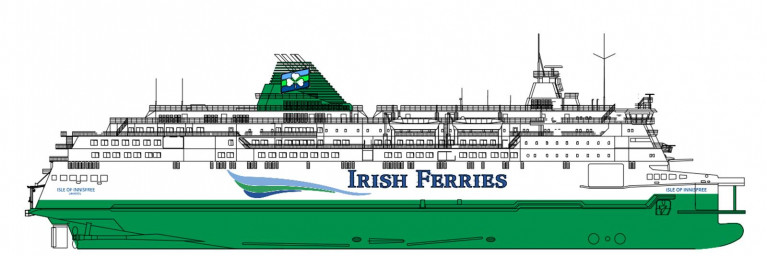Displaying items by tag: Isle of Innisfree
Dublin based operator, Irish Ferries has confirmed that one of its UK-France service ferries had encountered difficulties yesterday (3 March) evening following a small fire that broke out on board at 5.30pm.
The ferry company in a statement said the crew on board the 163m long Isle of Innisfree "were alerted to a small fire in the ship's engine room while the ship was sailing from Dover to Calais".
The 199I built ferry is one of three that Irish Ferries operate on the English Channel and where the 28,838 gross tonnage ferry had departed the port in Kent at 5pm.
The statement added that its crews train regularly to deal with incidents at sea and "the fire has now been extinguished".
At the time of the incident the Cypriot flagged Isle of Innisfree was carrying 94 passengers and 89 crew and that all are safe and accounted for.
The UK coastguard was informed and dispatched three lifeboats as a precautionary measure.
More from RTE News on the ferry that arrived safely into Calais after a tug according to BBC News had towed the ferry into port.
Afloat adds that while the Isle of Innisfree is off service, the route is reduced from three ferries down to a just a single ship the Isle of Inishmore. This is because Irish Ferries third Dover-Calais vessel, Isle of Inisheer is away for dry-docking at Harland & Wolff, Belfast.
Isle of Innisfree is no stranger to the Strait of Dover having served originally as Prins Philip for Belgium operator, RMT on the Dover-Ostende route.
Since 1992 the ferry has changed ownership several times until the Irish company acquired the ferry from DFDS, a rival on the French route also served by P&O Ferries.
Irish Ferries Second Strait of Dover Ferry Makes Maiden Crossing to Calais
Irish Ferries, a subsidiary of the Dublin based Irish Continental Group plc (ICG), have today added further capacity with the introduction of Isle of Innisfree to their existing short-Straits service of Dover-Calais.
Since Irish Ferries opened the new service out of the Port of Dover in June 2021, significant additional capacity has been added with the Isle of Inishmore, indicating a high level of confidence in the Short Straits. This investment in the Dover-Calais crossing is evidence of the resilience, value and dependability of the route and bolsters Dover's offering of an inbound ferry every 25 minutes.
Following berthing trials Afloat adds, the debut of the Isle of Innisfree today sees Irish Ferries already double their frequency on the Dover-Calais route since June. Moreover, with a third ship (name to revealed) due to join the fleet in January will enable Irish Ferries to offer up to 30 sailings per day on the route, with sailings in each direction approximately every 90 minutes.
Commenting, Doug Bannister, Chief Executive Officer at the Port of Dover, said: “The capacity added by Irish Ferries on the Dover-Calais route today is testament to the ongoing confidence in the Short Straits. The market continues to choose the high pace, frequency and capacity offered by Dover, and in turn, the Port offers customers more choice, moving from two to three operators in 2021.
Together with all our dedicated ferry operators, the Port of Dover is driving resilient supply chains, further enhancing our joint offering to customers. Dover is continuing to serve the market as the busiest and most efficient UK port – keeping people and goods flowing via the shortest and most efficient sea crossing between the UK and mainland Europe.”
Irish Ferries announced today the addition of a second ro-ro cruise ferry Isle of Innisfree to its Dover-Calais route joining Isle of Inishmore, which was launched just months ago onto the premier UK-France link, writes Jehan Ashmore.
Under the terms of the purchase agreement, title to the 28,833 tonne ship Calais Seaways transferred to Irish Continental Group (ICG) upon delivery yesterday. Following drydocking and rebranding into Irish Ferries livery, the 1,140 passenger/83 freight vehicles or 600 cars capacity ferry is expected to enter service within the first week of December.
The debut of the renamed ferry, Isle of Innisfree (the third to take the name) will double frequency on the short-sea link between Britain and mainland continental Europe, thus providing customers a complete UK landbridge service with their Irish Sea routes. In addition the two-ship service will enable Irish Ferries to be closer to rival DFDS three-ship operation, though P&O Ferries have four ferries plying on the Strait of Dover.
Isle of Innisfree, originally launched as Prins Filip was built in 1991 by the Boelwerf shipyard in Belgium, however did not enter service until the following year for RMT, a Belgium state operator that also linked the UK from Dover to Oostende. Despite several change of ownerships and under various renamings, the ferry has spent for the most part of a career plying between south east England and northern France.
The introduction of Isle of Innisfree offers a host of quality facilities for freight drivers/passengers such as a self-service restaurant, café/bar, Club Class lounge, onboard duty-free shop, children’s play area and spacious outdoor decks.
Commenting on the acquisition of secondhand tonnage, Andrew Sheen, Irish Ferries Managing Director, said: “We are delighted be able to add a second ship to our Dover / Calais route, with the ship doubling our frequency with a departure every 2 ½ hours rather than the current 5 hours between sailings. The ship underlines our commitment to this route and facilitates trade for both exporters and importers as well as ensuring capacity for essential passenger movements and greater choice for tourism”.
Afloat also adds the name of ferry chosen, Isle of Innisfree revives that of a previous vessel of the same name when ICG ordered their first custom-built newbuild which entered service on the Dublin-Holyhead in 1995. The order for Isle of Innisfree (II) on the Ireland-Wales route was much needed to modernise, as predecessor B&I Line (acquired in 1991 by ICG) was an ailing Irish state-owned company operating ageing smaller tonnage.
As for the first ever ferry named Isle of Innisfree, this took place in the early 1990's under the brand of B&I (when chartered-in by ICG). Despite the change of ownership, ICG retained the line's famous trading name until consigned to history at the start of 1995.
The second Isle of Innisfree built in the Netherlands served the Ireland-north Wales link until replaced by Isle of Inishmore in 1997 and which in turn was replaced by Ulysses in 2001. The cruiseferry continues to operate the Irish Sea service.
As referred above, the Isle of Innisfree, ICG eventually sold the renamed Kaitaki following years on charter in New Zealand as Afloat reported over the years. The ship continues to operate in the southern hemisphere for operator, KiwiRail. Their InterIander service links the north and south islands across the Cook Strait on the Wellington-Picton route.
A pair of larger passenger, freight train-enabled ferries have been ordered to replace Kaitaki along with two other fleetmates. The first of the newbuilds is due to enter service in 2025 and the second in the following year.
Both ro-pax ferries are to be built by South Korean shipyard Hyundai Mipo Dockyard which is currently building the Isle of Man Steam-Packet's newbuild ro-pax which is to be named Manxman and delivered in 2023.
The newbuild will replace Ben-My-Chree which was built by Van der Giessen de Nord that was also responsible for the construction of the Innisfree/Kaitaki and the Isle of Inishmore.
In addition the Dutch shipyard also built Blue Star 1 which is on charter to ICG following the transfer of Isle of Inishmore from the Rosslare-Pembroke route.






























































